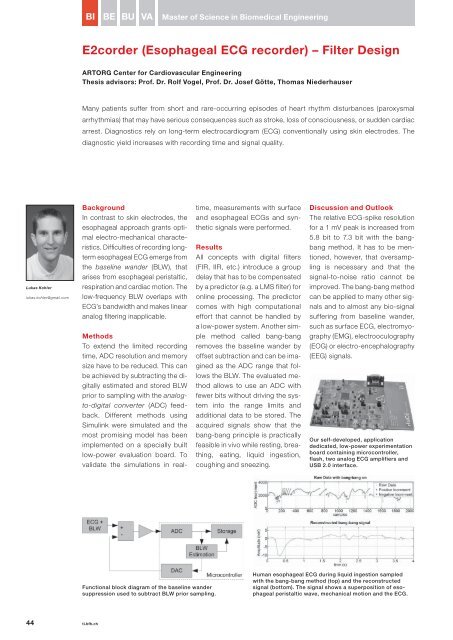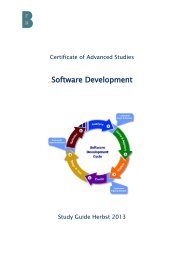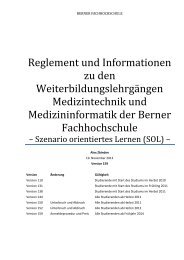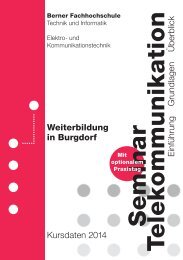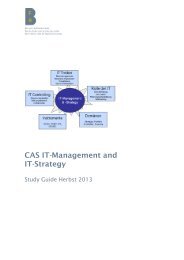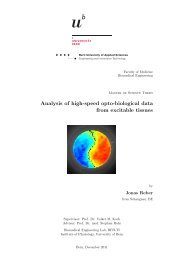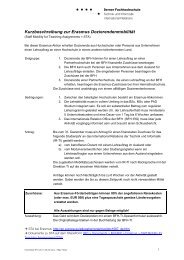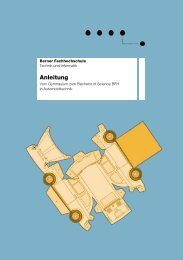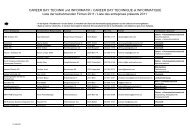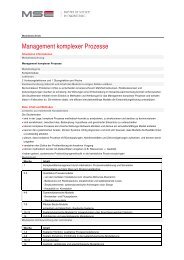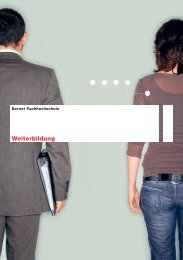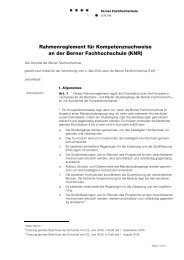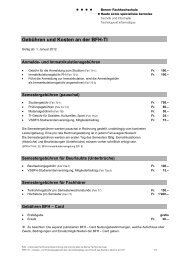Dernière édition Attention: Le pdf pèse environ 17 - BFH-TI - Berner ...
Dernière édition Attention: Le pdf pèse environ 17 - BFH-TI - Berner ...
Dernière édition Attention: Le pdf pèse environ 17 - BFH-TI - Berner ...
- Keine Tags gefunden...
Sie wollen auch ein ePaper? Erhöhen Sie die Reichweite Ihrer Titel.
YUMPU macht aus Druck-PDFs automatisch weboptimierte ePaper, die Google liebt.
BIBEBUVAMaster of Science in Biomedical EngineeringE2corder (Esophageal ECG recorder) – Filter DesignARTORG Center for Cardiovascular EngineeringThesis advisors: Prof. Dr. Rolf Vogel, Prof. Dr. Josef Götte, Thomas NiederhauserMany patients suffer from short and rare-occurring episodes of heart rhythm disturbances (paroxysmalarrhythmias) that may have serious consequences such as stroke, loss of consciousness, or sudden cardiacarrest. Diagnostics rely on long-term electrocardiogram (ECG) conventionally using skin electrodes. Thediagnostic yield increases with recording time and signal quality.Lukas Kohlerlukas.kohler@gmail.comBackgroundIn contrast to skin electrodes, theesophageal approach grants optimalelectro-mechanical characteristics.Difficulties of recording longtermesophageal ECG emerge fromthe baseline wander (BLW), thatarises from esophageal peristaltic,respiration and cardiac motion. Thelow-frequency BLW overlaps withECG’s bandwidth and makes linearanalog filtering inapplicable.MethodsTo extend the limited recordingtime, ADC resolution and memorysize have to be reduced. This canbe achieved by subtracting the digitallyestimated and stored BLWprior to sampling with the analogto-digitalconverter (ADC) feedback.Different methods usingSimulink were simulated and themost promising model has beenimplemented on a specially builtlow-power evaluation board. Tovalidate the simulations in realtime,measurements with surfaceand esophageal ECGs and syntheticsignals were performed.ResultsAll concepts with digital filters(FIR, IIR, etc.) introduce a groupdelay that has to be compensatedby a predictor (e.g. a LMS filter) foronline processing. The predictorcomes with high computationaleffort that cannot be handled bya low-power system. Another simplemethod called bang-bangremoves the baseline wander byoffset subtraction and can be imaginedas the ADC range that followsthe BLW. The evaluated methodallows to use an ADC withfewer bits without driving the systeminto the range limits andadditional data to be stored. Theacquired signals show that thebang-bang principle is practicallyfeasible in vivo while resting, breathing,eating, liquid ingestion,coughing and sneezing.Discussion and OutlookThe relative ECG-spike resolutionfor a 1 mV peak is increased from5.8 bit to 7.3 bit with the bangbangmethod. It has to be mentioned,however, that oversamplingis necessary and that thesignal-to-noise ratio cannot beimproved. The bang-bang methodcan be applied to many other signalsand to almost any bio-signalsuffering from baseline wander,such as surface ECG, electromyography(EMG), electrooculography(EOG) or electro-encephalography(EEG) signals.Our self-developed, applicationdedicated, low-power experimentationboard containing microcontroller,flash, two analog ECG amplifiers andUSB 2.0 interface.Functional block diagram of the baseline wandersuppression used to subtract BLW prior sampling.Human esophageal ECG during liquid ingestion sampledwith the bang-bang method (top) and the reconstructedsignal (bottom). The signal shows a superposition of esophagealperistaltic wave, mechanical motion and the ECG.44 ti.bfh.ch


